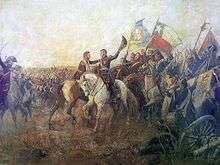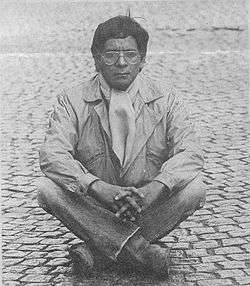Chilean Argentines
| |||||||
| Total population | |||||||
|---|---|---|---|---|---|---|---|
|
(429,708 (Chile-born and people of Chilean descent)) | |||||||
| Regions with significant populations | |||||||
| Mendoza · Buenos Aires · Patagonia | |||||||
| Languages | |||||||
| Chilean Spanish · Mapuche | |||||||
| Religion | |||||||
| Christianity · Judaism | |||||||
Chilean Argentines are Argentine citizens of Chilean descent or Chile-born people who reside in Argentina. Argentina is home to the largest Chilean diaspora group. According to the Argentine 2010 census, there are 191.147 Chileans living in the country (born in Chilean territory). An estimate 2003-2004 estimated Chilean descendants, born in Argentina to a Chilean father or mother, in 190,000.[1]
Other figures, such as those by The World Factbook, show a total population (including those born in Chile and their descendants) of 429,708 people.[2]
Chilean immigration to Argentina dates back to colonial times. During the War of Independence of Chile, the period known as the Patria Vieja, ended with the defeat of the patriot forces at the Battle of Rancagua on October 1 and 2, 1814. The patriots who were crossing the Andes took refuge in the United Provinces of the Río de la Plata. Some of them returned to their country with the Army of the Andes in 1817 achieving restore the independence of Chile.
Both countries share language, customs, history and one of the largest borders in the world, among other things.
History

The migration process between the two countries dates back to colonial times. Undoubtedly, a memorable case was that of Chilean migration to Argentina after the Battle of Rancagua and the Spanish reconquest of Chile between 1814 and 1817.
Since the late 19th century, there was a steady migration from the Chiloé Archipelago to the southern provinces of Argentina, for use on sheep farms as industrial workers. Since then, they are an important part of the Chilean population resident in southern Argentina, to the point that the term "chilote" is a derogatory nickname for any Chilean.
However, Chilean migration increased dramatically since the coup in 1973 Chilean coup d'état led by Augusto Pinochet. In this way, the peak of the Chilean migration to Argentina began, being able to see a notorious Chilean exile seeking refuge in the neighbouring country, after the Chilean military government initiated a wave of exiles opponents of the military regime, that joined the voluntary flight of many opponents, although this did not last long, as Argentina suffered a coup three years later. After the return of democracy in Chile in 1990, some citizens of that country have returned to their homeland, but others have definitely settled on Argentine soil, especially in the Patagonia region, where 53% live, exceeding 5% of total population of each province, and the region of Cuyo, where it is the 12% of the total population and where they have contributed in various ways, providing customs, food contributions, etc. The remaining 18% live in Buenos Aires.
See also
References
- ↑ INDEC. "Estimación de la población chilena en Argentina" (in Spanish).
- ↑ Chilenos en el Exterior - Comisión Bicentenario (26 December 2005). "Más de 857 mil personas residen fuera de las fronteras de nuestro país" (ASP) (in Spanish). www.gobiernodechile.cl. Retrieved 24 July 2008.
.jpg)




